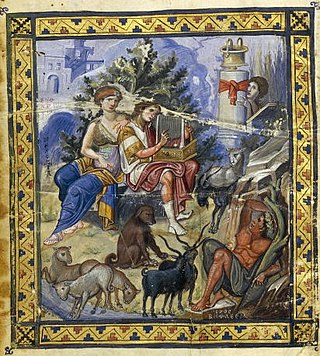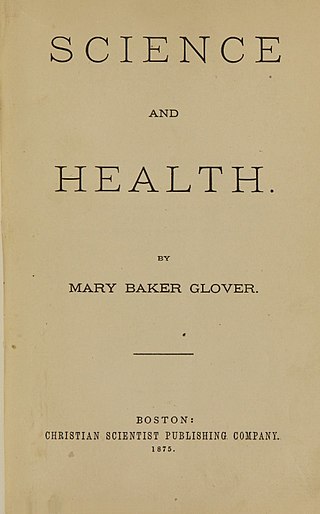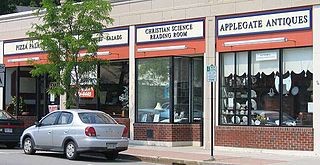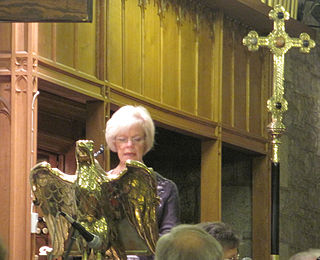
The Book of Psalms, also known as the Psalms, or the Psalter, is the first book of the third section of the Tanakh called Ketuvim ('Writings'), and a book of the Old Testament.

Great Lent, or the Great Fast, is the most important fasting season of the church year within many denominations of Eastern Christianity. It is intended to prepare Christians for the greatest feast of the church year, Pascha (Easter).

Science and Health with Key to the Scriptures by Mary Baker Eddy is, along with the Bible, one of two central texts of the Christian Science religion. Eddy described it as her "most important work". She began writing it in February 1872, and the first edition was published in 1875. She would continue editing it and adding to it for the rest of her life.

Christian Science is a set of beliefs and practices which are associated with members of the Church of Christ, Scientist. Adherents are commonly known as Christian Scientists or students of Christian Science, and the church is sometimes informally known as the Christian Science church. It was founded in 1879 in New England by Mary Baker Eddy, who wrote the 1875 book Science and Health with Key to the Scriptures, which outlined the theology of Christian Science. The book was originally called Science and Health; the subtitle with a Key to the Scriptures was added in 1883 and later amended to with Key to the Scriptures.

A Christian Science Reading Room is a facility operated as a public service by a Christian Science church in the community where that church exists. The local branches of The Mother Church in Boston, Massachusetts, maintain these rooms as a place where one may study and contemplate the Bible and Christian Science literature in a quiet atmosphere, similar to a library.

The Christian Science Publishing Society was established in 1898 by Mary Baker Eddy and is the publishing arm of The First Church of Christ, Scientist in Boston, Massachusetts.
Expository preaching, also known as expositional preaching, is a form of preaching that details the meaning of a particular text or passage of Scripture. It explains what the Bible means by what it says. Exegesis is technical and grammatical exposition, a careful drawing out of the exact meaning of a passage in its original context. While the term exposition could be used in connection with any verbal informative teaching on any subject, the term is also used in relation to Bible preaching and teaching. The practice originated from the Jewish tradition of the rabbi giving a "Dvar Torah", explaining a passage from the Torah, during the prayer services. Expository preaching differs from topical preaching in that the former concentrates on a specific text and discusses topics covered therein; whereas, the latter concentrates on a specific topic and references texts covering the topic.

David Martyn Lloyd-Jones was a Welsh Congregationalist minister and medical doctor who was influential in the Calvinist wing of the British evangelical movement in the 20th century. For almost 30 years, he was the minister of Westminster Chapel in London.
Biblical hermeneutics is the study of the principles of interpretation concerning the books of the Bible. It is part of the broader field of hermeneutics, which involves the study of principles of interpretation, both theory and methodology, for all forms of communication, nonverbal and verbal. While Jewish and Christian biblical hermeneutics have some overlap and dialogue, they have distinctly separate interpretative traditions.

A lectionary is a book or listing that contains a collection of scripture readings appointed for Christian or Jewish worship on a given day or occasion. There are sub-types such as a "gospel lectionary" or evangeliary, and an epistolary with the readings from the New Testament Epistles.
In Christian communities, Bible study is the study of the Bible by people as a personal religious or spiritual practice. In many Christian traditions, Bible study, coupled with Christian prayer, is known as doing devotions or devotional acts. Many Christian churches schedule time to engage in Bible study collectively. The origin of Bible study groups has its origin in early Christianity, when Church Fathers such as Origen and Jerome taught the Bible extensively to disciple Christians. In Christianity, Bible study has the purpose of "be[ing] taught and nourished by the Word of God" and "being formed and animated by the inspirational power conveyed by Scripture".
Orthros or útrenya in the Byzantine Rite of the Eastern Orthodox Church and the Eastern Catholic Churches, is the last of the four night offices, the other three being vespers, compline, and midnight office. Traditionally, in monasteries it is held daily so as to end immediately following sunrise, in contrast to parishes where it is held only on Sundays and feast days. It is often called matins after the office it most nearly corresponds to in Western Christian churches.

A lection, also called the lesson, is a reading from scripture in liturgy. In many Christian denominations, the readings of the day are appointed in the lectionary.

In Christianity, the Lord's Day refers to Sunday, the principal day of communal worship. It is the first day of the week in the Hebrew calendar and traditional Christian calendars, with the exception of European (workweek) calendars. It is observed by most Christians as the weekly memorial of the resurrection of Jesus Christ, who is said to have been raised from the dead early on the first day of the week. The phrase appears only once in Rev. 1:10 of the New Testament.

Septimus James Hanna, an American Civil War veteran and a judge in the Old West. He was a student of Mary Baker Eddy, who founded the Christian Science church. Giving up his legal career, he became a Christian Science practitioner, lecturer and teacher. Hanna occupied more leading positions within the church organization than any individual, serving as pastor, then First Reader of The Mother Church, as editor and associate editor of the periodicals, member of the Bible Lesson Committee, he served two terms as president of The Mother Church, he was teacher of the Normal (teachers) Class of 1907, later vice president and then president of the Massachusetts Metaphysical College.
The Divine Service is a title given to the Eucharistic liturgy as used in the various Lutheran churches. It has its roots in the Pre-Tridentine Mass as revised by Martin Luther in his Formula missae of 1523 and his Deutsche Messe of 1526. It was further developed through the Kirchenordnungen of the sixteenth and seventeenth centuries that followed in Luther's tradition.

The Gospel in Christian liturgy refers to a reading from the Gospels used during various religious services, including Mass or Divine Liturgy (Eucharist). In many Christian churches, all present stand when a passage from one of the Gospels is read publicly, and sit when a passage from a different part of the Bible is read. The reading of the Gospels, often contained in a liturgical edition containing only the four Gospels, is traditionally done by a minister, priest or deacon, and in many traditions the Gospel Book is brought into the midst of the congregation to be read.
A Reader in a Christian Science church is a member of the congregation who has been elected to serve in one of two positions responsible for church services. Each week's sermon in Christian Science churches is outlined in the Christian Science Quarterly, prepared months in advance, and is the same in all Christian Science churches, worldwide. As a lay church, the congregation elects readers from the congregation and they serve as readers for a set period of time. The sermons consist of passages from the Bible and Science and Health with Key to the Scriptures by Mary Baker Eddy, and are studied as lessons during the week and read aloud to the congregation on the Sunday following. The readers are referred to as the First Reader and Second Reader, according to the order in which they initially speak during the Sunday services. First Readers also conduct the Wednesday evening testimony meetings.

Rev. Irving Clinton Tomlinson was an American Universalist minister who converted to Christian Science, becoming a practitioner and teacher. For a time, he lived as one of the workers in the household of church founder, Mary Baker Eddy, later writing a book about his experiences called Twelve Years with Mary Baker Eddy.
Marietta Thomas Webb (1864–1951) was a Christian healer. She was one of the first Black Americans listed in The Christian Science Journal as a practitioner of healing through prayer, and the only Black American to have a personal healing testimony selected to appear in Mary Baker Eddy's seminal book Science and Health with Key to the Scriptures.















